Tire Size 305/70r16 vs 265/75r16
The section width is the key difference between 305/70r16 and 265/75r16 tires. The tire size 305/70r16 is about 1.57 inches wider than the 265/75r16 tire size. This affects the quality of the ride, the handling of the vehicle, the ground clearance, and other related factors.
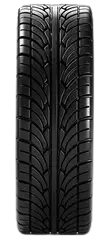

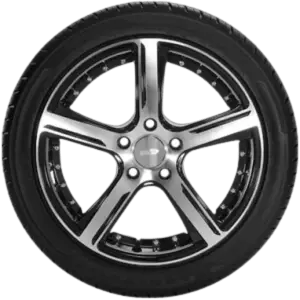





| / | R |

| / | R |
| Parameter | 235/35 R18 | 205/40 R18 | Differ. |
|---|---|---|---|
| Tire Height | |||
| Section Width | |||
| Circumference | |||
| Sidewall Height | |||
| Revolutions | |||
| Rim Size |
Fitment Guide
The overall diameter of 305/70r16 tires is 3.5% larger than 265/75r16 tires. Typically, replacement tires should be within 3% of the original size to avoid clearance issues or speedometer inaccuracies.
In this case, the 305/70r16 exceeds the 3% limit, so modifications like a lift kit might be required to accommodate the larger size and prevent rubbing or other fitment issues. It’s also important to match the load capacity of the original tires.
Gas Mileage
With a smaller contact patch and lower weight, the narrower 265/75r16 tire confers slightly better fuel efficiency over the wider 305/70r16. This can provide small but measurable fuel savings for daily drivers.
Ground Clearance
The diameter of 305/70r16 tires is 1.16 inches larger, providing extra ground clearance beneficial for off-roading.
However, this also causes a lower speedometer reading. The smaller 265/75r16 diameter reduces clearance risks but gives a higher speedometer reading.
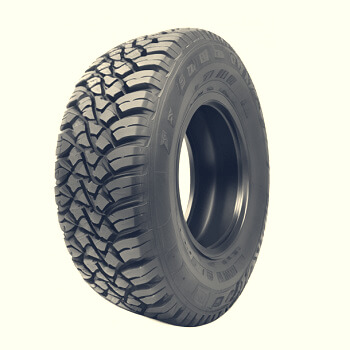
Ride Comfort
The 305/70r16’s larger diameter and wider width contribute to a comfortable ride quality and impact absorption, performing well both on- and off-road. By comparison, the 265/75r16 prioritizes on-road comfort over off-road capability.
Aesthetics
The wider 305-series width versus the narrower 265-series gives the 305/70r16 tire a bulkier, more aggressive aesthetic suited to trucks and SUVs.
The 265/75r16 has a slightly more stretched look owing to a taller sidewall and narrower tread.
Handling & Stability
The 265/75r16 provides responsive steering and handling precision thanks to a shorter, stiffer sidewall. But the 305/70r16 promotes stability and traction off-road while both deliver stable, precise handling on pavement.
Noise & Vibration
The 265/75r16 transmits more road noise and vibration due to its stiff sidewall. Meanwhile, the taller 305/70r16 sidewall dampens vibrations, but its wider tread produces slightly more noise.
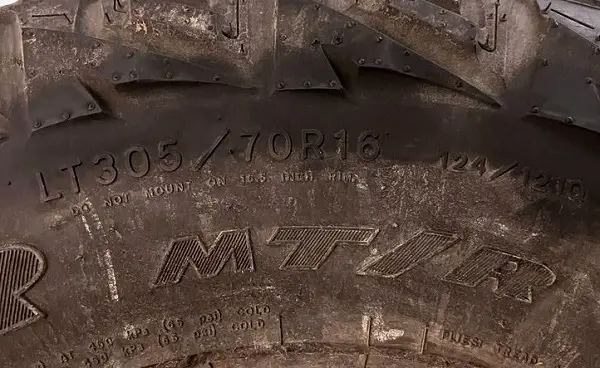
Durability & Wear
The 265/75r16 exhibits even treadwear with a potentially long service life. The larger 305/70r16 carries more weight, incurring more drivetrain wear but with the durability to withstand impacts.
Adverse Conditions
The narrower 265/75r16 can cut through to the road surface effectively in snow and ice. The wider 305/70r16 tread provides heavy traction in mud while added ground clearance aids off-road ability.
Speedometer Difference
At an actual vehicle speed of 20 mph, the 265/75r16 tires result in a speedometer reading of 21.68 mph.
Comparatively, the larger diameter 305/70r16 tires cause the speedometer to underreport speed at 20 mph. The difference is 0.66 mph between these sizes.
Can I Use 265/75r16 Instead of 305/70r16?
No, you should not use 265/75r16 tires instead of 305/70r16 tires. Using 265/75r16 instead of 305/70r16 results in a 3.5% decrease in diameter, exceeding the recommended 3% limit. It’s not advised, as this can impact speedometer accuracy and affect vehicle performance.
Even though the diameter difference is minor, when replacing tires it is best to stay within 3% or less of the overall diameter of the original tires for proper functionality and safety.
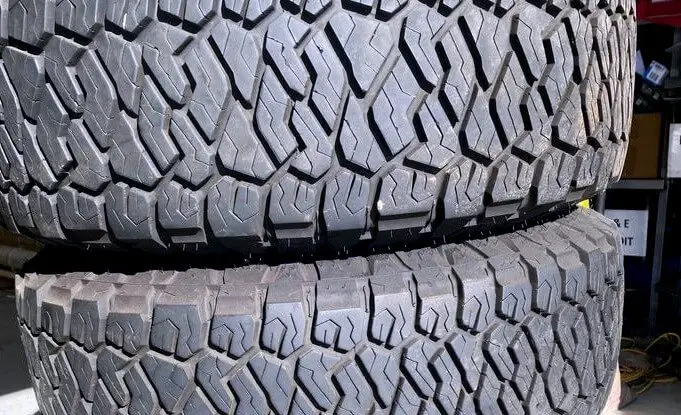
How Much Taller Is A 305/70r16 Tire Than A 265/75r16?
The 305/70R16 tire is 1.16 inches (29.5 mm) taller than the 265/75R16 tire. The height of a tire is the distance across it from one side to the other, passing through the center.
This measurement may vary slightly depending on the tire’s brand and model. The 305/70R16 tire has a height of 32.81 inches (833.4 mm), while the 265/75R16 tire has a height of 31.65 inches (803.9 mm).
How Much Wider Is A 305/70r16 Tire Than A 265/75r16?
The 305/70r16 tire is 1.57 inches (40 mm) wider than a 265/75r16 tire, representing a 13.1% increase in width. This measurement indicates the width of the tire from the inner sidewall to the outer sidewall.
The 305/70R16 tire has a width of 12.01 inches (305 mm), while the 265/75R16 tire has a width of 10.43 inches (265 mm).
What Does 305/70r16 Mean?
The tire size 305/70r16 can be expressed as 32.8x12R16 in inches. The tire size “305/70r16” signifies a tire that is 305 millimeters wide with an aspect ratio of 70%, meaning the tire’s height is 70% of its width. It features radial construction and is designed for a 16-inch wheel rim.
What Does 265/75r16 Mean?
The tire dimensions 265/75r16 are the same as 31.7×10.4R16 in inches. The tire size “265/75r16” indicates a tire with a width of 265 millimeters, an aspect ratio of 75% (meaning the tire’s height is 75% of its width), radial construction denoted by “r,” and designed for a 16-inch wheel rim.
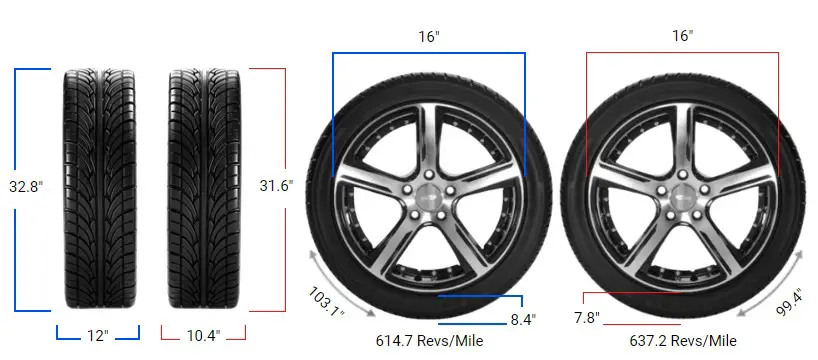
265/75r16 vs 305/70r16
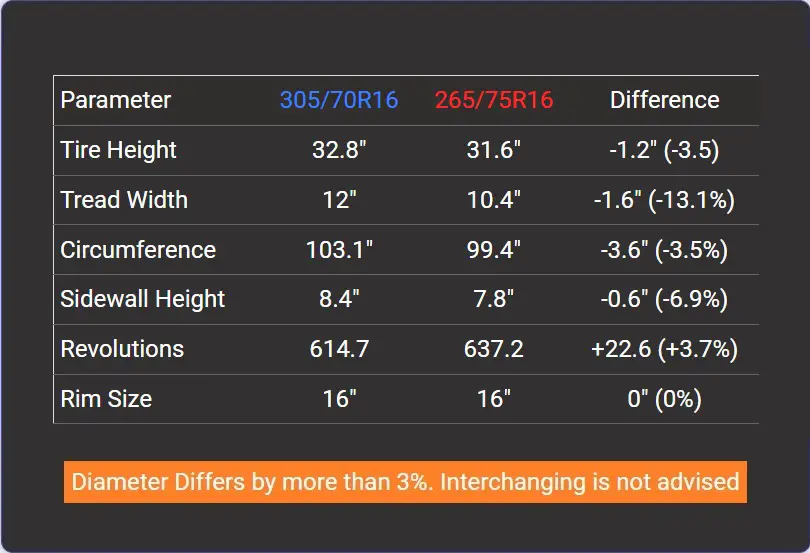
Our Observation
Overall, while the 265/75r16 offers marginal benefits in fuel economy and handling, the 305/70r16’s strengths in ride quality, traction, aesthetics, and off-road clearance make it the more versatile option.
Though the diameter exceeds typical sizing thresholds, the 3.5% difference is small enough that the 305/70r16 can work on most vehicles with minor adaptations.
We recommend the wider, more durable 305/70r16 for drivers prioritizing all-terrain capability. However, the narrower 265/75r16 excels for those focused strictly on responsive on-road performance and efficiency. Either tire serves daily drivers well, with only subtle trade-offs differentiating them.

Meet Caitlin McCormack, a Tire Size Expert and Blogger Passionate About Everything Related to Tires. With Years of Experience in the Tire Industry, Caitlin Has Become an Expert in Tire Sizes and Their Impact on Vehicle Performance.
